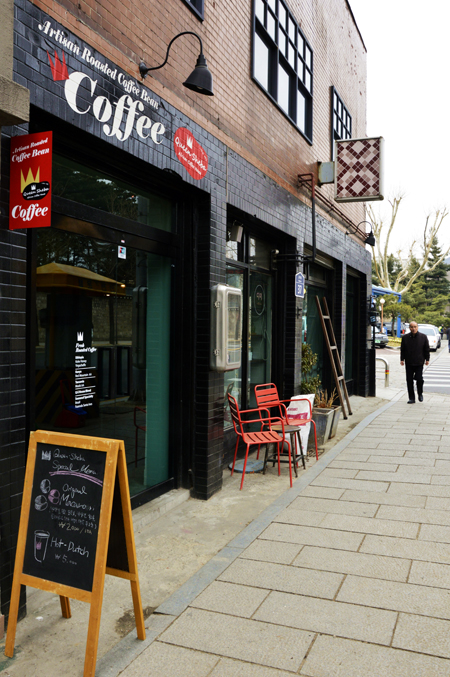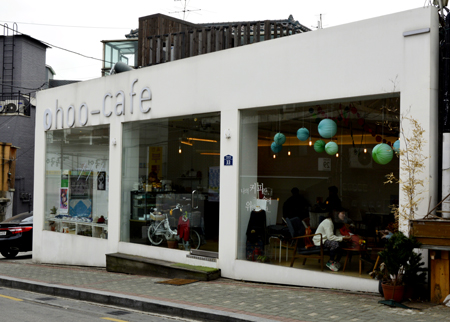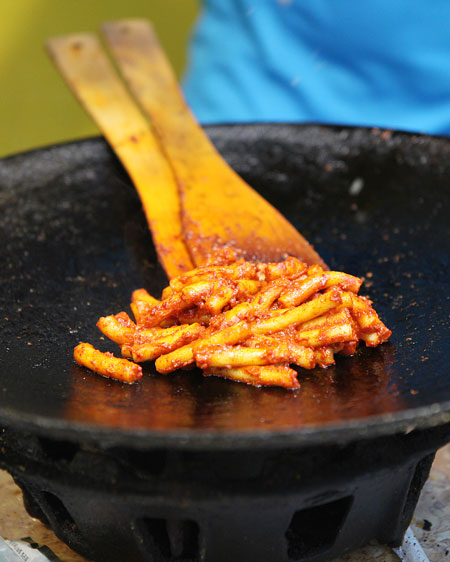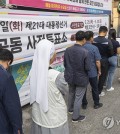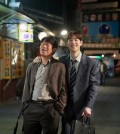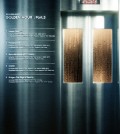- California Assembly OKs highest minimum wage in nation
- S. Korea unveils first graphic cigarette warnings
- US joins with South Korea, Japan in bid to deter North Korea
- LPGA golfer Chun In-gee finally back in action
- S. Korea won’t be top seed in final World Cup qualification round
- US men’s soccer misses 2nd straight Olympics
- US back on track in qualifying with 4-0 win over Guatemala
- High-intensity workout injuries spawn cottage industry
- CDC expands range of Zika mosquitoes into parts of Northeast
- Who knew? ‘The Walking Dead’ is helping families connect
Rediscovering Seochon
Between the alleyways lie the stories
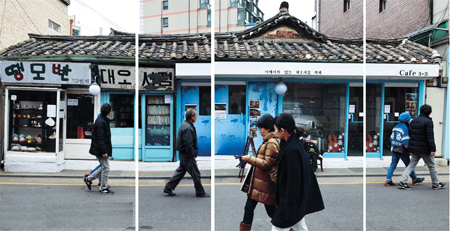
Four different photos of the same location – Daeo Seojeom, the oldest second-hand book store in Seoul – were cut and connected to create this image.
(Korea Times photo by Yun Suh-young)
By Yun Suh-young
Seochon, an old neighborhood near Gyeongbok Palace in Seoul, is a deceptively hip and happening place.
At first sight, the area doesn’t look at all like a magnet for the social media crowd that it is. But then you stroll along the narrow alleys behind the main street and navigate the quirky web of old houses, small shops, restaurants and art galleries, and Seochon begins to open up as a vibrant and fun destination.
“There’s more to Seochon than meets the eye. It has its unique character that is different from the cafe-covered Samcheong-dong or the neighboring Bukchangdong,” said Seol Jae-woo, a travel guide and author of the book “Seochon Direction.” He is a long-time Seochon resident, born and raised in the area.
“If people just come here for a meal and then leave, they won’t discover the hidden side of Seochon. The richest experiences are actually hidden behind the alleyways,” he said.
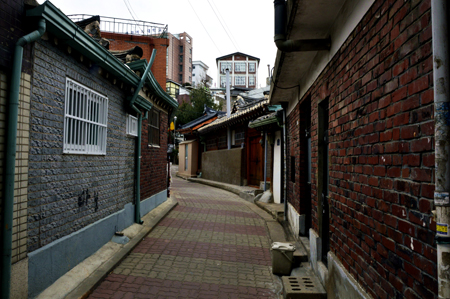
An alleyway in Ogin-dong, Jongno-gu, Seoul. Alleyways best show the characteristics of Seochon. (Korea Times photo by Yun Suh-young)
Overview
The name Seochon could be translated as “village in the west.” Most people assume that the name comes from the neighborhood’s location, that is to the west of Gyeongbok Palace. However, some believe that the name is actually derived from the old name for Mt. Inwang, which used to be called “Seosan,” or “mountain in the west.”
Seochon, stretching from the west gate of Gyeongbok Palace to the foot of Mt. Inwang, encompasses about 15 “dong” (the lowest administrative unit of districts and cities), including Tongui-dong, Cheongun-dong, Ogin-dong, Hyoja-dong and Sajik-dong.
There are many ways to tour Seochon, but using exits 2, 3 or 4 at Gyeongbok Station is a good start.
While critics would say that Seoul is an urban concrete jungle that doesn’t have much to show for its 600-year history, Seochon is one of the few areas in the city where the flow of time is manifested elegantly rather than ruthlessly. The cohesion of old houses, shops and traditional outdoor markets is unique.
The neighborhood has a different ambiance from the nearby Bukchon, a village stretching over Gahoe-dong and Gye-dong, famous for clusters of “hanok,” or traditional Korean houses. Seochon has fewer hanok buildings and a mix of buildings from Japanese style architecture to modern galleries.
“In Seochon, Tongui-dong has strong characteristic in architecture. During the Japanese occupation of Korea (1910-45), Japanese officials who worked for the governor general used to live in this area. That’s why some houses have Japanese-style roofs. After the liberation of Korea from Japan, galleries came here making this into an artistic village,” said Seol.
“Seochon is a town where the middle class used to live. Residents here were artists and craftsmen— mostly skillful people— who were somewhere between the yangban (gentry) class and commoners. The people here were dynamic and there are traces of this on stones because artists would carve them into artworks.”
Seochon’s rise
Seochon’s popularity as a travel destination increased in the past year since the opening of the “dosirak” (lunch cafe) program at Tongin Market, a traditional market which boasts of an over 90-year history.
The lunch cafe program began at the end of 2012 by merchants in the market who were looking for ways to boost profits.
The idea was to give out food trays so that visitors could pick the banchan (side dishes) that they wished from any store that participated in the program. Since most of the stores participated, visitors could choose from a variety of different meals.
What’s unique about the program is that when you buy food, you don’t pay with ordinary currency but with “yeopjeon,” brass coins which used to be used as currency in the old days but which are no longer in use except within the market.
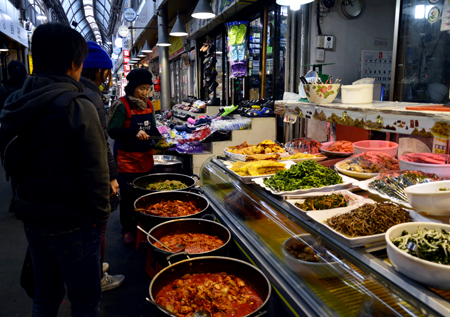
A store owner scoops side dishes onto the food trays of foreign tourists at the Tongin Market in Ogin-dong, Jongno-gu. Side dishes are bought with yeopjeon, old brass coins used as a unique currency in the market, as part of
the “dosirak (lunch) program” organized by merchants.
(Korea Times photos by Yun Suh-youn)
Food trays are provided only after exchanging Korean won for yeopjeon at the lunch cafe headquarters. One yeopjeon is equal to 500 won so with 5,000 won you receive 10 coins.
The banchan costs between 500 won and 1,000 won depending on the type or amount, and bowls of rice and soup cost two coins each.
Since the launch of the program, the dosirak at the market has become quite popular among tourists, students and foreigners who find the experience fun and unique.
Tongin Market is also famous for another of its specialties, “gireum tteokbokki,” a stir-fried version of rice cakes in hot sauce. It is the snack U.S. Ambassador Sung Kim took U.S. Secretary of State John Kerry to taste during his recent visit to Seoul.
There are multiple stores claiming they are the “wonjo” or originators of the dish, although the real woman credited for creating it has died and left her daughter to run the shop.
Another factor contributing to Seochon’s rise is the rapidly proliferating cafes in the alleyways behind the market and across from the market near the gallery sites.
For young visitors to Seochon, the charmingly decorated cafes and cute restaurants which nestle next to old houses are other attractive reasons to visit.
The cafe street in Ogin-dong has small cafes lined up along the street, but in order for it to establish itself as a “cafe street,” it needs more stores to fill in the gaps.
Seochon alleyways
As much as Seochon is famous for the market, food and cafes, its character is best understood while walking along the alleyways.
“I think Seochon is best characterized by the alleyways. There’s something called backstreet culture here. We can find interesting types of architecture along the way. Hanok are more like a fantasized image of Seochon, but it’s really the alleyways that create the unique atmosphere,” said Seol.
According to Seol, the alleyways in Seochon are historic because they match 90 percent with a 100-year old map called “jijeokdo” which was a map of alleyways.
“When you tour with a specific destination in mind, you might easily overlook the alleyways. But take careful notice of them. For instance, at this house, you’ll notice a fence which is built with giwa (roof tiles). Ironically, this is an Italian restaurant. It shows how architecture blended with the environment,” Seol said.
Traces of artists are found along the streets.
At one across from the west gate of Gyeongbok Palace, there’s Boan Yeogwan, an old inn which was built 80 years ago. The inn used to be home to contemporary artists who lived here cheaply. Poet Seo Jeong-ju, novelist Kim Dong-in, and writer Yi Sang were among the few who lived and worked here. Now the place is used as a project gallery and opens only occasionally.
On the other side of Seochon in Ogin-dong, there’s a house tucked away at a cul-de-sac. This is the home of Lee Sang-beom (1897–1972), a painter who was famous for landscape paintings.
His house and studio is designated cultural heritage No. 171 and is well preserved by his daughter-in-law who still lives there. His works were offered as gifts to foreign dignitaries by Presidents Syngman Rhee and Park Chung-hee.
The Suseong-dong Stream is another place often overlooked while touring the area. There used to be a stream flowing through the area, which was why it was called Suseong-dong, meaning a town full of the sound of water. The bridge, which is still there, matches one in an old painting produced during the Joseon Kingdom (1392-1910).
“The scenery here was the first and only one to be listed as a cultural heritage. Usually, landscapes are not considered cultural heritage,” said Seol.
“You can walk up to hiking trail on Mt. Inwang from here. There are walkways that lead to the mountain.”








